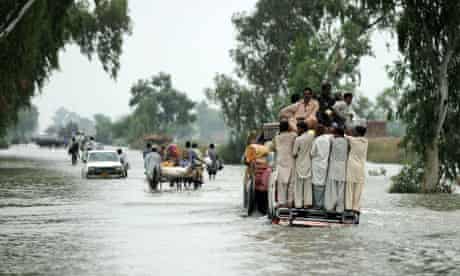Rarely a week goes by when issues around photography are not in the news. This week, the photographs on Facebook of handcuffed and blindfolded Palestinian detainees posted by an ex-Israeli soldier unleashed shockwaves. A few weeks ago, Time magazine's cover of the Afghan woman stirred up debates that are ongoing. As viewers, we respond and react. We demand action. Yet, day after day, the media also brings us images that should shock our sensibilities – but do not quite manage to do so.
The floods in Pakistan have given rise to a veritable deluge of photographs documenting devastation. On a daily basis, we have been seeing representations of untold suffering, as people struggle to survive, while filth and chaos reign around them. Nevertheless, despite efforts to mobilise relief, a certain degree of apathy often accompanies our responses to such images. Unlike the photograph of the Afghan woman, these are not one-offs.
The problem is so much larger than photography can ever hope to capture that they wash over us. For two facts stand out when it comes to how we gather news of disasters elsewhere: first, photo-documentary plays a key part, and second, there is a predictable sameness to such photographs. Whether it be Hurricane Katrina, the tsunami, Pakistan or Haiti back in January, the photo-reportage that emerges inevitably confirms the uniformity of human suffering, the base commonality of despair, concerns, needs and pain.
Too often, they also confirm that the hardest hit are always the poor, whether they be in Louisiana or Nowshera. Yet, for those of us who are far away and better off – concerned, no doubt, but personally unaffected – comes a sense of deja vu leading to a slightly jaded response. We feel sympathy, but not an urge to ask big questions or to battle seriously for action. So of what use are these images if they cannot move us out of our comfort zone when we, the globally privileged, are precisely those who can make a difference?
The plain fact is that the suffering of others is part of what we expect to see from the media. Photo-reportage of disasters and mass displacements are mainstream images, despite the efforts made by individual photographers to provide original and distinct points of view. They also confirm our relative safety: this suffering is that of others, and not ours. And so the images are solely seen in passing.
Perhaps our pallid responses signal a crisis of conscience. Perhaps we have problems of our own to deal with. Or is there something slightly inuring about photo-reportage? Does this signal the limits of photography's documentary potential?
Could it be, then, that images that actually work in terms of seizing our minds are those that do not try to put facts squarely before us? Instead, the images that shake us most present their audience with conundrums, bringing into our sightline paradoxical juxtapositions. When an Israeli ex-soldier posts photographs on Facebook of herself "at work" (albeit guarding handcuffed and blindfolded Palestinian prisoners), in exactly the same way in which so many of us post images of ourselves in the workplace, we are faced at once with the intensely familiar and the totally extraneous and abhorrent.
For the same images also churn up in our collective memories the photographs of Abu Ghraib that continue to haunt the democratic conscience of the west. And in bringing all of this together, in aligning us all together as co-users of Facebook, we, the "good" people of the world, feel the unexpected discomfort of rubbing shoulders with the troubling shadows and the muffled screams of our troubled times.
Such images are spaces of contradiction. They force us to ask questions, to think again. They plunge us into uncertainty. Who knows – the irony may then be that when it comes to what makes a photograph work, it is precisely the earnest zeal for transparent documentary that undermines photography's potential as a mobilising force.

